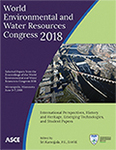World Environmental and Water Resources Congress 2018
A Study of Urban Water Supply System Resilience for the Capital City of Delhi, India
Publication: World Environmental and Water Resources Congress 2018: International Perspectives, History and Heritage, Emerging Technologies, and Student Papers
ABSTRACT
India is the second largest democracy with a population of about 1325 million. About 30% (around 400 million) population is living in cities, out of which around one-third is living in urban slums. The country has more than 65 million-plus cities, out of which 8 cities are mega-cities. Delhi (also known as the National Capital Territory of India) is a metropolitan region in India that includes the national capital city, New Delhi. It is the world’s second most populous city and the largest city in India in terms of area. Delhi has a population of around 19 million with the population growth rate of 2.1% per annum during the decade 2001–2011 with a population density of 11297 persons/sq. km area. Providing sustainable water supply to this capital city is a major challenge. The source of raw water for producing potable water in Delhi is Yamuna River, Upper Ganga Canal, and Satluj River through Bhakra Dam (Govind Sagar reservoir) as well as through local Ranney and tube wells. The Delhi Jal Board (DJB) is responsible for distributing clean and pure water in Delhi. However, it is a great challenge for managing drinking water to this National Capital Territory of Delhi in India due to various reasons such as heavy permanent and floating population, large expansion, environment deterioration, large competing demands, and depleting raw water sources under changing climatic conditions. At present, DJB is only able to distribute about 848 million gallons per day (MGD) which includes 100 MGD of groundwater. Further, there are only 4 to 6 hours of water supply in some of the important areas of South Delhi. The objective of this paper is to perform a quantitative assessment of water supply in Delhi using Water Evaluation and Planning System (WEAP) software under different climatic conditions.
Get full access to this article
View all available purchase options and get full access to this chapter.
REFERENCES
Alam, M., Rais, S., & Aslam, M. (2009). Hydro-chemical survey of groundwater of Delhi, India. Journal of Chemistry, 6(2), 429–436.
CPHEEO, G. (1999). Manual on water supply and treatment. New Delhi: GoI.
Haberman, D. (2006). River of love in an age of pollution: The Yamuna river of northern India. Univ of California Press.
Lather, A. S., Jain, V. K., Jain, S., & Vikas, S. (2009). Leadership Styles in Relation to Conflict Resolution Modes: A Study of Delhi Jal Board (DJB). Vilakshan: The XIMB Journal of Management, 6(1).
Misra, K., & Malhotra, G. (2011). Water management: the obscurity of demand and supply in Delhi, India. Management of Environmental Quality. An International Journal, 23(1), 23–35.
Nandan, D., Nair, K. S., Tiwari, V. K., Piang, L., Raj, T. P. S., & Kumar, P. (2010). Evaluation of MAMTA scheme in national capital territory of Delhi: report. New Delhi: National Institute of Health and Family Welfare, 112.
Information & Authors
Information
Published In
World Environmental and Water Resources Congress 2018: International Perspectives, History and Heritage, Emerging Technologies, and Student Papers
Pages: 34 - 45
Editor: Sri Kamojjala, Las Vegas Valley Water District
ISBN (Online): 978-0-7844-8139-4
Copyright
© 2018 American Society of Civil Engineers.
History
Published online: May 31, 2018
Authors
Metrics & Citations
Metrics
Citations
Download citation
If you have the appropriate software installed, you can download article citation data to the citation manager of your choice. Simply select your manager software from the list below and click Download.
